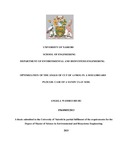| dc.description.abstract | The Mouldboard plough is a common tillage implement used in Kenya. The draught characteristics and ability to maintain desired depths and speed of operation at different frog angles is unknown. This study aimed at optimizing the angle of cut of a frog of a mouldboard plough operating in sandy clay soil. This objective was achieved through the study of the soil-cut interactions. The measurable quantity in the study of soil- cut interactions was draught force. Draught force is an indicator of the power to be consumed hence the cost of tillage.
Tillage field experiments were carried out in University of Nairobi – Upper Kabete Campus. Data obtained from the field was evaluated in three different ways; Saunders equation, Dynamometer and Discrete Element Modelling (DEM). Saunders equation calculated draught force incorporating geometric parameters of the plough body components, ploughing speed and depth additionally the physical properties of the soil. The dynamometer used was digital and recorded the draught requirements in situ. DEM was used to simulate the field experiment using a software called EDEM that calculated the draught requirements.
The soil- cut interactions were studied at three different frogs angles of 30°, 40° and 50°.The speed of tillage was calculated to be an average of 1.5m/s for the low speed and 3.6m/s for the high speed. The depths of tillage were measured as an average of 8.0cm, 17.0cm and 24.0cm for the three frog angles used. Draught forces determined for the low speeds (1.5m/s) were at range of 0.7kN to 1.0kN for depths of 8.0cm. At depths of 17.0 cm the range of forces was 1.0kN to 1.4kN. At the depths of 24.0cm the draught forces calculated were a range of 1.4 kN to 1.9kN. For high speeds (3.6m/s) the draught forces were at ranges of 0.8kN to 1.3kN, 1.4kN to 2.2kN and 2.2kN to 3.2kN respectively for the depths aforementioned.
The results suggest that draught forces increase significantly with increase in the depth linearly. This relationship shows the importance of regulating the depth of tillage. Draught forces increased with increase in speed of tillage and the relationship was a second order polynomial equation. The study concluded that the 30° angle frog was the optimal frog to
vi
use in a mouldboard plough operating in sandy clay soil as it had minimum average draught force of 0.8 KN. Thus at this angle, we experience minimum draught at an optimum speed and at friable moisture content of the soil.
Key words: Tillage, simulation, DEM, soil-cut interactions and draught force | en_US |

